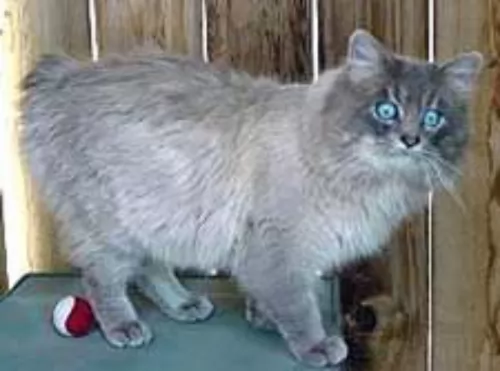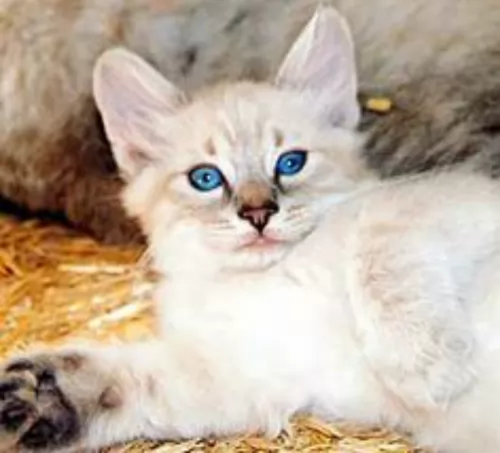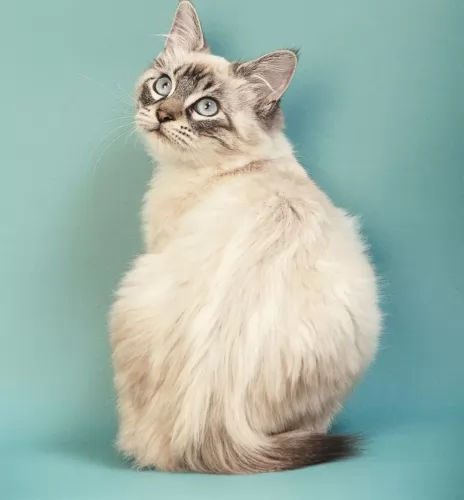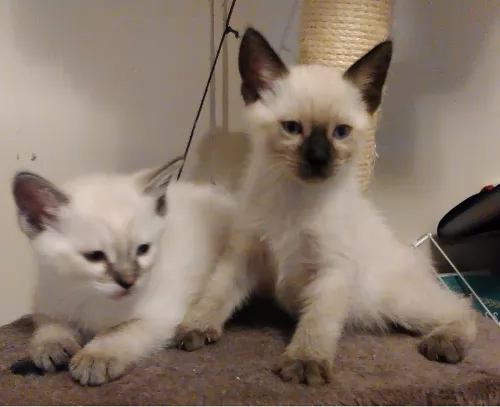 Petzlover
Petzlover Owyhee Bob is originated from United States but Persian is originated from Iran. Both Owyhee Bob and Persian are having almost same weight. Owyhee Bob may live 3 years more than Persian. Both Owyhee Bob and Persian has same litter size. Owyhee Bob requires Low Maintenance. But Persian requires Moderate Maintenance
Owyhee Bob is originated from United States but Persian is originated from Iran. Both Owyhee Bob and Persian are having almost same weight. Owyhee Bob may live 3 years more than Persian. Both Owyhee Bob and Persian has same litter size. Owyhee Bob requires Low Maintenance. But Persian requires Moderate Maintenance
 This breed of cat is a cross between two fantastic cat breeds – the Manx and the Siamese. It’s a cat breed that is recognized by the Rare and Exotic Feline Registry.
This breed of cat is a cross between two fantastic cat breeds – the Manx and the Siamese. It’s a cat breed that is recognized by the Rare and Exotic Feline Registry.
The Owyhee Bob is also just casually referred to as the Owyhee and it's an experimental feline breed.
It’s from the USA and is polydactyl, which means that the cat carries the genes of the Manx while the other breed used to create them is the Siamese.
 Cat lovers the world over know the Persian cat very well. It's a beautiful long-haired cat breed with its familiar round face and blunt muzzle.
Cat lovers the world over know the Persian cat very well. It's a beautiful long-haired cat breed with its familiar round face and blunt muzzle.
It is not really known when long-haired cats first appeared, or where the Persian originated but their history stems from Persia or Iran as it is known today, where it seems they were first sighted.
The cats were grey-coated and some were white and soon the cats arrived in Britain. They were introduced to the United States in the 1900s. The cat was developed first by the English, and then also by American breeders after the Second World War and the breeding of these cats has also meant a lot of coat colors.
 The cat has spotted or marbled markings on his coat which can be long or short. In fact, the coat can be in all colors and patterns.
The cat has spotted or marbled markings on his coat which can be long or short. In fact, the coat can be in all colors and patterns.
Its a medium to large-sized cat, muscular with a round head and medium to large-sized ears that have some feathering around the rounded tips.
The tail too can be long or short but the preferred look is the stumpy tail. The cat has large oval eyes that are wide-set and blue, like one of the parent cats - the Siamese.
The Owyhee Bob is a social cat and very playful. He likes nothing more than to be part of his human family. He is intelligent too and becomes a loving and loyal pet.
The personality of the Owyhee Bob is sweet-tempered and social. They are also these kinds of cats that follow you wherever you go and when you sit down, they’re eager to be in your lap.
These cats don’t do well in homes where their humans work all day, every day and they are left in solitude hour after hour.
Remember that the socialization you give your kitten as well as the environment it grows up in can play a role in the temperament of your cat.
 The Persian cat is a medium- to large-sized cat and is heavily boned. He can weigh between 3 and 6kg.
The Persian cat is a medium- to large-sized cat and is heavily boned. He can weigh between 3 and 6kg.
He has stocky legs, a thick neck, small ears, round head, round eyes, and the face is flat or blunt. The kittens are gorgeous balls of fluff.
The coat of the Persian is thick, long, and silky. People many times think only of a white Persian, when in fact the cat comes in many colors and patterns. Eye color for the cat can be blue, green, brown, copper or even odd-eyed.
The Persian isn’t the most active of cats, so attention will need to be given to exercising the cat so as to manage his weight. This cat will also need to have his nutrition controlled to stay in shape and in good health.
Persians enjoy games with their human family and will need some toys to encourage play and exercise.
He is placid and calm but that doesn’t mean he can’t have bursts of energy. They’re quieter than other cats, are sweet-natured, preferring to live in quieter, less boisterous households.
They aren’t loudly vocal but communicate with their eyes and their soft voices. They won’t get on well with small, noisy children but can be loving pets and companions of older children who allow them their own space.
 The Owyhee cat in your home becomes a wonderful pet. They’ve got such playful, jaunty personalities and they’re clever too.
The Owyhee cat in your home becomes a wonderful pet. They’ve got such playful, jaunty personalities and they’re clever too.
Social, sweet-tempered, and active, you won’t be disappointed by having such an awesome feline companion in your home.
After all, he has fantastic parent breeds – the Siamese and the Manx – and the two blended together brings out all the most amazing characteristics in the Owyhee Bob cat.
 The amicable personality of the Persian cat makes it easy to have these cats in your home. The long hair becomes a bit of an issue as the cat sheds quite a bit.
The amicable personality of the Persian cat makes it easy to have these cats in your home. The long hair becomes a bit of an issue as the cat sheds quite a bit.
They’re sweet, quiet cats and they don’t demand attention from you. They are more than happy just lying quietly in a warm spot. They are calm, loving cats and it's no wonder that they are still such a popular breed of cat.
 Every cat, regardless of how healthy can get ill. If you don’t want your cat to become a parent, he or she will need to be spayed or neutered as well which comes with a host of health benefits.
Every cat, regardless of how healthy can get ill. If you don’t want your cat to become a parent, he or she will need to be spayed or neutered as well which comes with a host of health benefits.
If you worry about the cost of vet bills, you can rather pay a small amount each month for pet insurance.
Certainly, as a cat owner, you need to recognize the signs and symptoms of some of the more common illnesses your cat could get so that you can get your feline pet to the vet before he gets too sick by neglecting it.
Cancer is a killer disease where cells grow uncontrollably so that the disease spreads to every area of the body. Cats can get different types of cancer but you need to know some of the symptoms to watch out for.
Your cat may lose weight, you’ll maybe notice a difficulty with swallowing, he has a sore that won’t heal, he doesn’t want to eat, he is losing weight and he may have a new, unusual lump.
This is a tricky illness and cats infected with this disease may not show symptoms until years after they were infected. With this disease, the cat’s immune system is weakened and the cat is open to all kinds of other secondary infections.
Parasites can make a cat seriously ill. It is why vets deworm kittens. Infestations of worms can cause a host of symptoms. Certainly, your cat is listless, dull and the hair may even fall out.
 The structure of this cat’s head can mean some health problems. Hereditary Polycystic kidney disease is prevalent with the Persian cat. It is an inherited condition that causes cysts to form in the kidneys. These cysts are actually present from birth, growing larger over time and interfering with kidney function and ending in kidney failure.
The structure of this cat’s head can mean some health problems. Hereditary Polycystic kidney disease is prevalent with the Persian cat. It is an inherited condition that causes cysts to form in the kidneys. These cysts are actually present from birth, growing larger over time and interfering with kidney function and ending in kidney failure.
Also, with a larger breed cat such as the Persian, hip dysplasia is a problem.
Persians are also susceptible to malocclusion which means ‘incorrect bite’. This particular condition can affect the cat’s ability to grasp and actually hold food. So much so in fact, that now pet food manufacturing companies have even developed specially-shaped kibble to cater particularly for the Persian.
 Your Owyhee Bob is a social cat so he will require interest and companionship from his human owners.
Your Owyhee Bob is a social cat so he will require interest and companionship from his human owners.
Choose the best cat food that there is. Your Owyhee Bob cat is a carnivore and he will require excellent cat food to ensure his health. Make sure he has a constant supply of fresh, cool water.
Provide a litter tray and clean it out every day.
Provide a warm, dry bed for your cat, stimulating toys, a scratching-post, climbing tree, food and water bowls, a collar and grooming accessories.
Get you Owyhee Bob to the vet when he shows any sign of illness. Make sure that he gets his kitten vaccines.
 The Persian cat’s coat is long and silky and because he is a fairly heavy shedder, he will require regular brushing – certainly once or twice a week to get rid of that loose hair. It is important to brush and also cut the hair so as to get rid of the tangled knots that form.
The Persian cat’s coat is long and silky and because he is a fairly heavy shedder, he will require regular brushing – certainly once or twice a week to get rid of that loose hair. It is important to brush and also cut the hair so as to get rid of the tangled knots that form.
While brushing your Persian, make sure that his eyes and nose are clear. This is important because the flat face creates problems with these cats.
Excellent cat food for your Persian involves reading labels and understanding what brands are best for your beautiful cat. The Persian cat is a carnivore and will require high-quality food rich in protein.
Speak to your vet if you are in any doubt about the best food for your cat’s health and wellbeing. Make sure your pet has a constant supply of fresh, cool water.
Make sure to keep the litter box clean. Buy a small rake from the pet shop and rake up your cat's feces every single day and dispose of them.